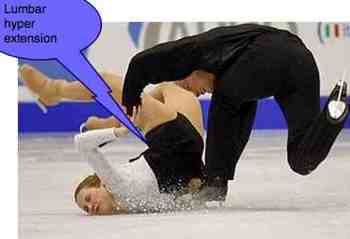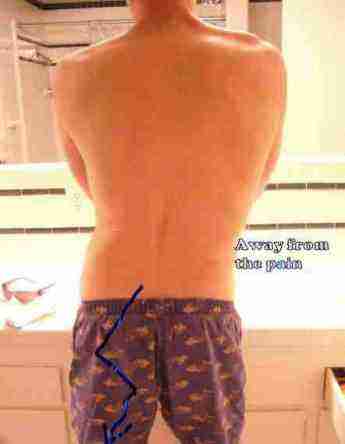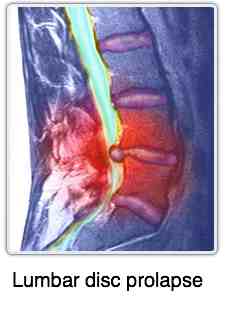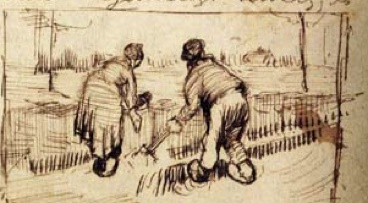L4 lumbar spine casefile
L4 lumbar spine casefile shows how a lower back injury can utterly ruin a person's life.

Postero lateral disk herniation
Postero lateral disk herniation makes you lean to the side, away from the pain. L4 lumbar spine casefiles tend to go more steeply than their colleagues at L5 into an antalgic list; the lowermost vertebra is stabilised onto the pelvis by strong ligaments. Those above are more exposed.

L4 lumbar spine casefile
L4 lumbar spine casefile is the story of a young woman who had a serious skiing accident eleven years ago. For reasons of privacy obviously I cannot show a picture of her. Instead a young man standing in a posture known playfully as the Pisa sign. It's not a generally used orthopaedic term; you can see the obvious list to starboard in his back. It's what's known as an antalgia in the literature.
Mrs M had a serious hyperextension fall when she was 30 years old. Immediately after the accident she started going into an antalgic posture to the right, what I describe as the Pisa sign, with such sharp pains that she would literally fall to the ground, sometimes ten times in a day.
In the accident her spine was forced into hyperextension.
The photo above clearly shows the antalgic sign. Notice how this young man leans to the right to gain relief from pain. It's an involuntary posture; he has no control of it. It's a temporary posture, indicative in my book of a serious postero lateral disk herniation, or less commonly a facet syndrome; others have a different opinion.
The pain in our lumbar spine case file radiated into the typical
pattern into her left buttock and down the side of her thigh. She recalled that in the beginning the ache radiated into the great toe, but latterly it didn't pass below the knee.
The pain was aggravated by the so called Dejeurine's triad; coughing, sneezing and bearing down on the toilet were all agonising. Descending the stairs caused severe discomfort in the sacroiliac joint. Sitting was often a nightmare.
To add insult to injury, she had coccyx pain.
She struggled for eleven long years with this condition. Physical therapy helped in the beginning; physiotherapy and antiinflammatory drugs brought minimal relief.
A valsalva manoever, as in bearing down as on the toilet, was painful; it's a sure indication of a slipped disc. Lhermitte's sign too was very painful; flexing her head and neck as you would normally do when getting into the car caused severe low back pain.
The Slump test was positive provoking left lower lumbar back pain and a numb feeling in her left leg. The straight leg raise of Lasegue for a sciatic nerve impingement was positive, but only in her back; that's good.
Four of five sacroiliac joint tests were strongly positive in the left SIJ.
Bending forwards provoked pain in the low back and a tight feeling in the left leg. Leaning backwards was even more uncomfortable.
There was weakness in her left lower leg. She had difficulty raising her great toe.
At home, it's easy to test yourself for sciatica, and for weakness in the leg. However, the interpretation of these signs requires experience; nevertheless they may help to give you some inkling as to what is happening in your own lower back and how serious it is; see the link lower down.
The disc between the fourth and fifth lumbar vertebrae can pinch two different nerve roots. In her case it was the fifth nerve root which forms a large component of the sciatic nerve.

To test yourself to see if you have any progressive weakness in the leg from a pinched nerve.
Disc protrusion
Disc protrusion in the lower back is a very common phenomenon; when it escapes beyond the annulus fibrosis we call it a prolapse, but these terms are loosely used. L4 lumbar spine casefiles can be very severe like the one below.

Chiropractic
Chiropractic tries to address the cause and not the symptoms but sometimes that's easier said than done when faced with a serious lumbar disc protrusion cum prolapse. Leg pain is a common feature in many L4 lumbar spine casefiles.
Can you raise your big toe off the ground?
Assessment
It was a confusing example for our L4 lumbar spine casefile. Some tests pointed strongly to a postero lateral disk herniation, others to a lumbar facet syndrome, and some to a sacroiliac joint injury.
From a diagnostic point of view we like backs to be neat and tidy but the truth is, in a serious injury, sometimes more than one tissue is injured, hence the confusing signs.
Had we a scan I suspect it would reveal an extrusion of the disc into the intervertebral foramen. Then, on bending backwards, the disc fragment is caught in a pincer like movement between the facet joints.
The pain in her leg, and weakness in her foot was not a good sign. She was on the verge of surgery; and needless to say desperate.
There were no miracles. She had a lot of treatment, more than I am accustomed to giving; 14 consultations over a 6 months period and slowly, gradually the pain reduced. By the end of that time she had little discomfort.
The treatment consisted of lumbar manipulation and the Thompson drop protocol for the sacroiliac joint treatment.
At home she sat much less, did not use the vacuum cleaner, iced her back and did our lower back exercises very faithfully. Normally I recommend doing them twice a day, once before arising in the morning and last thing at night; but she did them several times during the day as well.
The basic, initial exercises take only forty seconds.
Even the coccyx pain was gone. We used a coccyx pillow for two months, and external mobilisation of the coccyx. Very occasionally it may need to be done internally.
That was a year ago. Today, giving me the impetus to write this L4 lumbar spine casefile, she consulted me again for the first time in eleven months. Exceptionally good year until she slipped and fell on the ice last week.
This time she knew not to wait 11 years before consulting a chiropractor.
The problems aren't severe and I expect to see her 3 to 4 times. She does her exercises faithfully, and has accepted the limitations of a weak back; she doesn't do stupid heavy lifting.
Alas serious conditions like this are hardly ever cured. It's like diabetes and will need life long management. Primarily, just like diabetes, that management is done by her at home; it means a disciplined life of back exercises, walking or swimming regularly, and occasionally chiropractic therapy.
Remember to treat any case file, including this L4 lumbar spine casefile with a pinch of salt! They are not scientifically
validated. But I hope you found it interesting, and for Mrs M, she doesn't give a damn
whether there is yet hard chiropractic research that will convince
our critics of the effectiveness of chiropractic. Actually there is an abundance of research, but there are none so blind as those who will not see as the French proverb goes.
At this link you'll find the lower back exercises mentioned above that our patient did so patiently and faithfully; with enormous benefit. Don't feel helpless after a serious lower back injury; just by doing these exercises faithfully you raise your chances of recovery by at least fifty percent.
This is where the coccyx is found.

Below is a link to the other common type of lumbar disc protrusion, called a postero medial disk herniation. The following are a summary of the terms used above which you may want to follow up.
Bending and twisting is what gets most backs. Gardeners in particular need to be doing core exercises every day, particularly if they have sedentary jobs during the week.
Do you recognise Holland's most famous painter? He sold only two paintings in his whole lifetime, bought out of pity by his brother; today his paintings sell for hundreds of millions of dollars each. Is it any wonder he committed suicide?

Core exercises for the lower back.
INTERESTING LINKS
- LOWER BACK AND LEG PAIN ...
- More about LEG PAIN DURING PREGNANCY ...
- FOOT PAIN ... can be the cause of your low back pain.
Have A Question about your lower back?
I receive many questions about Chiropractic. It might be help with a spinal condition, but it might also be from a person who can't walk after a hip operation, or some such thing.
I will do that by answering your questions personally, but it will be converted to a Web Page so others can benefit from your questions. Omit your name if you like.
However, do understand that, in the main, I'm going to be directing you, should it be pertinent, to a Chiropractor in your neck of the woods. I'll respond to all reasonable inquiries, but please be specific, and give as much detail as you can.
Do understand that lower back pain is extremely complex, so I can only give general guidelines. There's no substitute for a careful thorough chiropractic examination.
What Other Visitors Have Said
Click below to see contributions from other visitors.
If you find my answer useful, please ask friends to grade it.
Burning tingling in feet and sometimes in hands along with left leg feeling longer and groin ache and lower left side back and hip ache 




Home > L4 lumbar spine casefile > Burning tingling in feet and sometimes in hands along with left leg feeling longer and groin …
Tingling in the head 




Dear Dr.
Thanks for taking the time and reading my concern and I highly appreciate your advise.
I injured my lower back in October which lead to …
L5S1 disk degeneration , Modic change, lower back pain 




Hi, I has Magnetic Resonance of lumbar spine in May 2009 and it
showed spongiosa inflammation, disk degeneration and inflammation
at L5 S1 (Modic …
L4/5 rupture, Chronic LBP & DDD but nerve symptoms inconsistent with Sciatica; Refers to Knee & Front thighs – Help! Not rated yet
I had been under regular chiropractic care for degenerative C5/6 and neck spasm before injuring my low back nearly 14 years ago. A lumbar MRI after being …
Pain in left ilium following hip surgery five months ago. Not rated yet
I am 65 years of age and had hip surgery done five months ago due to much pain. I still limp, cannot put a lot of pressure on that leg, cannot climb stairs …
Lower back pain on the left side upper left butt cheek and knee pain Not rated yet
I had a baby on December 15 that was 9.3 pounds and has since gotten up to approx. 22 pounds. I am somtines unable to bend down and pick him upi because …
Upper leg pain Not rated yet
I have this upper leg pain that goes from my knee up the side of my leg. Sometimes it will go down to my foot. It will keep me awake some nights.
…
Tests for low back pain / Slump Test Not rated yet
I am a retired physician who does medico-legal work. Therefore, I review chiropractic records in order to help clients of attorneys receive adequate compensation …
Did you find this page useful? Then perhaps forward it to a suffering friend. Better still, Tweet or Face Book it.
